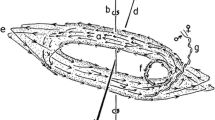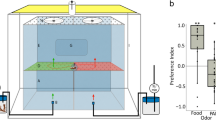Summary
Female dance-flies, Empis borealis L., gather to swarm, and males carrying nuptial gifts visit swarms for mating. Field observations and experiments were performed on this behaviorally sex-role reversed species to test models of lekking behavior. The key predictions were: (1) female preference model: male visiting rate and mating rate should increase with the number of females in swarm (swarm size), (2) hotspot model: male visiting rate should be independent of swarm size, and (3) hotshot model: swarm size should be positively correlated with the body size of the largest female in swarm. We found that male visiting rate and mating rate increased with swarm size, and that mating rate per female increased with swarm size. Males also mated more often in larger swarms than in smaller ones. Both males and females visited swarm sites even in the absence of other individuals. When females were successively removed from swarm sites more males than females on average arrived at these sites: 2.25 males per female. When no individuals were present at the swarm site, arriving males moved on to another site, whereas arriving females generally stayed. Larger experimental swarm-markers attracted both more males and more females and even more males when swarming females were present. There was no correlation between mean or median female size in swarms and the number of females in swarms. Thus, the female preference model and the hotspot model were corroborated, while other models were judged unlikely to explain swarming behavior in E. borealis.
Similar content being viewed by others
References
Alatalo RV, Höglund J, Lundberg A, Sutherland WJ (1992) Evolution of black grouse leks: female preferences benefit males in larger leks. Behav Ecol 3:53–59
Alcock J (1987) Leks and hilltopping in insects. J Nat Hist 21:319–328
Alexander RD (1975) Natural selection and specialized chorusing behavior in acoustical insects. In: Pimental D (ed) Insects, science, and society. Academic Press, New York, pp 35–77
Allan JD, Flecker AS (1989) The mating biology of a mass-swarming mayfly. Anim Behav 37:361–371
Arak A (1988) Callers and satellites in the natterjack toad: evolutionary stable desision rules. Anim. Behav 36:416–432
Avery MI (1984) Lekking in birds: choice, competition and reproductive constraints. Ibis 126:177–187
Bateson P (1983) Mate choice. Cambridge University Press, Cambrdidge
Beehler BM, Foster MS (1988) Hotshots, hotspots, and female prefrence in the organization of lek mating systems. Am Nat 131:203–219
Bradbury JW (1977) Lek mating in the hammerheaded bat. Z Tierpsychol, 45:225–255
Bradbury JW (1981) The evolution of leks. In: Alexander RD, Tinkle DW (eds) Natural selection and social behavior, recent research and new theory. Chiron Press, New York, pp 138–169
Bradbury JW (1985) Contrasts between insects and vertebrates in the evolution of male display, female choice, and lek mating. In: Hölldobler B, Lindauer M (eds) Experimental behavioral ecology and sociobiology. Gustav Fischer Verlag, New York, pp 286–293
Bradbury JW, Davies NB (1987) Relative role of intra- and intersexual selection. In: Bradbury JW, Andersson MB (eds) Sexual selection: testing the alternatives. John Wiley & Sons, Chichester, pp 143–163
Bradbury JW, Gibson RM (1983) Leks and mate choice. In: Bateson P (ed) Mate choice. Cambridge University Press, Cambridge, pp 109–138
Brittain JE (1982) Biology of mayflies. Annu Rev Entomol 27:119–147
Chvála M (1983) The Empidoidea (Diptera) of Fennoscandia and Denmark. II. Fauna Entomol Scand 12:1–279
Chvála M, Wagner R (1989) Family Empididae. In: Soós A, Papp L (eds) Catalogue of Palaearctic Diptera. Vol 6. Therevidae-Empididae. Akadémiai Kiadó, Budapest, pp 228–336
Darwin C (1871) The descent of man, and sexual selection in relation to sex. John Murray, London
Downes JA (1969) The swarming and mating flight of Diptera. Annu Rev Entomol 14:271–298
Emlen ST, Oring LW (1977) Ecology, sexual selection, and the evolution of mating systems. Science 197:215–223
Gruhl K (1924) Paarungsgewohnheiten der Dipteren. Z Wiss Zool 122:205–280
Gruhl K (1963) Sind Tänze von Weibchen bei Empis and Rhamphomya (Diptera) an gewisse Sondermerkmale gebunden? Mitt Dtsch Entomol Ges 22:88–96
Haddow AJ, Corbet PS (1961) Entomological studies from a high tower in Mpanga Forest, Uganda. V. Swarming activity above the forest. Trans Roy Entomol Soc London 113:284–300
Halliday TR (1983) The study of mate choice. In: Bateson P (ed) Mate choice. Cambridge University Pess, Cambridge, pp 3–31
Halliday TR, Verell PA (1986) Sexual selection and body size in amphibians. Herpetol J 1:86–92
Hedlund L, Robertson JGM (1989) Lekking behaviour in crested newts, Triturus cristatus. Ethology 80:111–119
Hibino Y (1986) Female choice for male gregariousness in a stink bug, Megacopta punctitissimum (Montandon) (Heteroptera, Plataspidae). J Ethol 4:91–95
Höglund J, Robertson JGM (1990) Female preference, male decision rules and the evolution of leks in the great snipe Gallinago media. Anim Behav 40:15–22
Janetos AC (1980) Strategies of female choice: A theoretical analysis. Behav Ecol Sociobiol 7:107–112
Lederhouse RC (1982) Territorial defence and lek behaviour of the swallowtail butterfly, Papilio polyxenes. Behav Ecol Sociobiol 10:109–118
Okubo A, Chiang HC (1974) An analysis of the kinematics of swarming of Anarete pritchardi Kim. (Diptera: Cecidomyidae). Res Popul Ecol 16:1–42
Oring L (1982) Avian mating systems. In: Farner D, King J, Parkes K (eds) Avian biology VI. Academic Press, New York, pp 1–92
Parker GA (1978) Evolution of competitive mate searching. Annu Rev Entomol 23:173–196
Phillips JB (1990) Lek behaviour in birds: do displaying males reduce nest predation? Anim Behav 39:555–565
Pont AC (1987) ‘The mysterious swarms of sepsid flies’: an enigma solved? J Nat Hist 21:305–317
Queller DC (1987) The evolution of leks through female choice. Anim Behav 35:1424–1432
Savolainen E (1978) Swarming in Ephemeroptera: the mechanism of swarming and the effects of illumination and weather. Ann Zool Fenn 15:17–52
Shelly TE (1990) Waiting for mates: variation in female encounter rates within and between leks of Drosophila conformis. Behaviour 107:34–48
Simmons LW, Parker GA (1989) Nuptial feeding in insects: Mating effort versus paternal investment. Ethology 81:332–343
Sullivan RT (1981) Insect swarming and mating. Florida Entomol 64:44–65
Svensson BG, Petersson E (1987) Sex-role reversed courtship behaviour, sexual dimorphism and nuptial gifts in the dance fly Empis borealis (L.). Ann Zool Fenn 23:323–334
Svensson BG, Petersson E (1988) Non-random mating in the dance fly Empis borealis: The importance of male choice. Ethology 79:307–316
Svensson BG, Petersson E, Forsgren E (1989) Why do males of the dance fly Empis borealis refuse to mate? The importance of female age and size. J Insect Behav 2:387–395
Svensson BG, Petersson E, Frisk M (1990) Nuptial gift size prolongs copulation duration in the dance fly Empis borealis. Ecol Entomol 15:225–229
Thornhill R, Alcock J (1983) The evolution of insect mating systems. Harvard University Press, Cambridge
Tuomikoski R (1938) Phänologische Beobachtungen über die Empididen (Diet.) Süd- and Mittelfinnlands. Ann Entomol Fenn 4:213–247
Tuomikoski R (1939) Beobachtungen uber das Schwärmen und die Kopulation einiger Empididen (Dipt.). Ann Entomol Fenn 5:1–30
Vehrencamp SL, Bradbury JW (1984) Mating systems and ecology. In: Krebs JR, Davies NB (eds) Behavioural ecology: An evolutionary approach. Blackwell, Oxford, pp 251–278
Wittenberger JF (1979) The evolution of mating systems in birds and mammals. In: Marler P, Vandenbergh J (eds) Handbook of behavioral neurobiology. Plenum Press, New York, pp 271–349
Wrangham RW (1980) Female choice of least costly males: a possible factor in the evolution of leks. Z Tierpsychol 54:357–367
Author information
Authors and Affiliations
Additional information
Correspondence to: B.G. Svensson
Rights and permissions
About this article
Cite this article
Svensson, B.G., Petersson, E. Why insects swarm: testing the models for lek mating systems on swarming Empis borealis females. Behav Ecol Sociobiol 31, 253–261 (1992). https://doi.org/10.1007/BF00171680
Received:
Accepted:
Issue Date:
DOI: https://doi.org/10.1007/BF00171680




